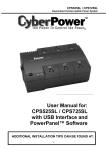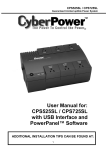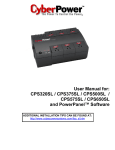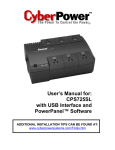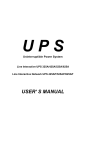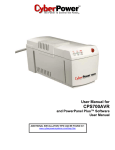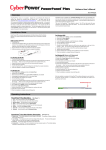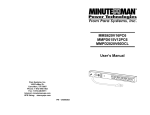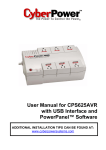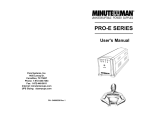Download Minuteman MN 325/MN 525 User`s manual
Transcript
MN 325/MN 525 User’s Manual TABLE OF CONTENTS Safety Instructions....... ... .. ... ... ... ...1 Description……………………………..1 Determining Power Requirements…..2 Hardware Installation Guide………….2 Software Installation Guide…………..3 Software User Manual………………..4 Battery Replacement Instructions..... 8 LED Indicators………………………..10 Trouble Shooting Guide…………… .11 Specifications………………………. 12 Declaration of Conformity ………… .13 Warranty... ... ... ... ... ... ... ... ... ... . 14 Thank you for purchasing a MINUTEMAN UPS Product. To enjoy all the features and benefits of this Uninterruptible Power Supply (UPS), please read and follow all installation and operation instructions completely. This UPS is designed to provide power protection for connected electronic equipment. The accompanying MINUTEMAN PowerCenter software saves data, closes open applications and automatically shuts down your computer system in an intelligent and orderly manner. FCC Notice This equipment has been tested and found to comply with the limits for a Class B Digital Device, pursuant to Part 15 of the FCC Rules. These limits are designed to provide reasonable protection against harmful interference in residential installation. This equipment generates, uses and can radiate radio frequency energy and, if not installed and used in accordance with the instructions, may cause harmful interference to radio communications. However, there is no guarantee that interference will not occur in a particular installation. If this equipment does cause harmful interference to radio or television reception, which can be determined by turning the equipment off and on, the user is encouraged to try to correct the interference by one or more of the following measures: (1) Reorient or relocate the receiving antenna. (2) Increase the separation between the equipment and receiver. (3) Connect the equipment into an outlet on a circuit different from that to which the receiver is connected. (4) Consult the dealer or an experienced radio/TV technician for help. Any special accessories needed for compliance must be specified in the instruction. CAUTION: A shielded-type power cord is required in order to meet FCC emission limits and to prevent interference to the nearby radio and television reception. It is essential that only the supplied power cord be used. Use only shielded cables to connect I/O devices to this equipment. CAUTION: Any changes or modifications not expressly approved by the guarantee of this device could void the user’s authority to operate the equipment. MN 325/MN 525 User’s Manual Uninterruptible Power Supply (UPS) IMPORTANT SAFETY INSTRUCTIONS (SAVE THESE INSTRUCTIONS) This manual contains important safety instructions. Please read and follow all instructions carefully during installation and operation of UPS. Read this manual thoroughly before attempting to unpack, install, or operate. CAUTION! To prevent the risk of fire or electric shock, install in a temperature and humidity controlled indoor area, free of conductive contaminants. (Please see specifications for acceptable temperature and humidity range). CAUTION! To reduce the risk of electric shock, do not remove the cover. Authorized Service Personnel must perform repairs and maintenance. No user serviceable parts inside. CAUTION! Hazardous live parts inside can be energized by the battery even when the AC input power is disconnected. CAUTION! UPS must be connected to an AC power outlet with fuse or circuit breaker protection. Do not plug into an AC wall outlet that is not grounded. If you need to de-energize this equipment, turn off and unplug the UPS. CAUTION! To avoid electrical shock, turn off the UPS and unplug it from the AC power source before servicing the battery or installing a computer component. DO NOT USE FOR MEDICAL OR LIFE SUPPORT EQUIPMENT! MINUTEMAN UPS does not sell products for life support or medical applications. DO NOT use in any circumstance that would affect operation or safety of any life support equipment or with any medical applications or patient care. DO NOT USE WITH OR NEAR AQUARIUMS! To reduce the risk of fire or electric shock, do not use with or near an aquarium. Condensation from the aquarium can cause the UPS to short out. DESCRIPTION SWF Indicator (MN 525 Only) The Site Wiring Fault (SWF) LED will illuminate to warn the user that a wiring problem exists, such as bad ground, missing ground or reversed wiring. If the SWF LED is illuminated, disconnect all of the equipment from the UPS and have an electrician check to ensure the AC wall outlet is wired correctly. Battery/Surge Outlets Provides battery-powered/surge outlets for the connected equipment and insures uninterrupted operation of your equipment during a power failure. Circuit Breaker Surge Only Outlets Serial Port to PC The circuit breaker provides overload and fault protection. Under normal operating conditions, the circuit breaker is depressed. Provides surge protection for non-critical equip- This port allows connection and communication ment. from the DB-9 serial port on the computer to the Power Switch UPS. The UPS communicates its status to the Can be used as a master on/off switch for equip- MINUTEMAN PowerCenter software. This interment connected to the battery-powered outlets. face is also compatible with the UPS service Power On Indicator provided by Windows NT and Windows 2000. This LED is illuminated when the utility condition RJ 11 Phone Jacks is normal and the UPS outlets are providing Protects any standard modem, fax or single line power, free of surges and spikes. telephone. 1 INSPECTION The package contents: (1) MINUTEMAN PowerCenter software (floppy disk); (1) Serial interface cable (DB-9); (1) Telephone cable; (1) User’s Manual; (1) Warranty registration card; (1) Platinum Protection Policy; (1) UPS. HOW TO DETERMINE THE POWER REQUIREMENTS OF YOUR EQUIPMENT 1. Make sure that the total Volt-Amp (VA) requirements of your computer, monitor and peripheral equipment does not exceed 1200VA for the MN 325 or 1440VA for the MN 525. 2. Ensure that the equipment plugged into the battery-powered outlets does not exceed the UPS’s rated capacity. If UPS’s rated capacities are exceeded, an overload condition may occur and cause the UPS to shut down and trip the circuit breaker. 3. If the power requirements of your equipment are listed in values other than Volt-Amps (VA), convert Watts (W) or Amps (A) into VA by doing the calculations below. Note: The equation below only calculates the maximum amount of VA that the equipment can use, not what is typically used by the equipment at any given time. Users should expect usage requirements to be approximately 60% of below value to estimate power requirements: Watts (W) x 1.82 = VA or Amps (A) x 120 = VA Add the totals for all of the equipment and multiply this total by 0.6 to calculate actual requirements. Note: Many factors can affect the amount of power that your computer system will require. The total load that you will be placing on the battery-powered outlets should not exceed 80% of the UPS’s capacity. Hardware Installation Guide 1. Your new UPS may be used immediately upon receipt. However, charging the battery for at least 4-hours is recommended to ensure that the battery’s maximum charge capacity is achieved. Charge loss may occur during shipping and storage. To recharge the battery, plug the power cord into the AC wall outlet and turn the power switch on. Note: The MN 525 will charge the battery with the power switch on or off. 2. If you wish to use the software, connect the enclosed serial interface cable to the serial port on the UPS and an open serial port on the computer. If you are not going to use the software, you do not need to connect the cable. 3. With the UPS unit off and unplugged, connect your computer, monitor, and any externally powered data storage device (Zip drive, Jazz drive, Tape drive, etc…) into the battery power supplied outlets. Plug your peripheral equipment (printer, scanner, speakers) into the full-time surge protection outlets. DO NOT plug a laser printer, copier, space heater, vacuum or other large electrical device into the UPS. The power demands of these devices will overload and possibly damage the UPS. 4. To protect a fax, phone or modem, connect a telephone cable from the wall jack outlet to the IN jack of the UPS. Connect a telephone cable from the OUT jack to the modem port on your computer. The OUT jack can be used to protect a telephone or fax machine. 2 MN 325/MN 525 User’s Manual Uninterruptible Power Supply (UPS) 5. Plug the UPS into a 2 pole, 3 wire grounding receptacle (AC wall outlet). Make sure the wall branch outlet is protected by a fuse or circuit breaker and does not service equipment with large electrical demands (e.g. refrigerator, copier, etc…). Note: DO NOT use extension cords, power or surge strips on the input or the output of the UPS. 6. Depress the power switch to turn the UPS on. The power on indicator light will illuminate and the UPS will “beep” once. 7. If an overload is detected, an audible alarm will sound and the UPS will emit one long beep. To correct this, turn the UPS off and unplug at least one piece of equipment from the batterypowered outlets. Wait 10-seconds. Make sure the circuit breaker is depressed and then turn the UPS on. 8. Your UPS is equipped with an auto-charge feature (MN 525 only). When the UPS is plugged into an AC wall outlet, the battery will automatically recharge. 9. To maintain optimal battery charge, leave the UPS plugged into an AC wall outlet with the power switch turned on at all times. 10. To store your UPS for an extended period, cover and store it with the battery fully charged. Recharge the battery every three months to ensure battery life. MINUTEMAN POWERCENTER SOFTWARE INSTALLATION GUIDE Note: Use of the software is optional. The UPS will provide surge protection and battery backup without the software. You must use the software if you wish to have the automatic shutdown feature. FOR WINDOWS 95/98/Me 1. Turn the UPS off and unplug it. 2. Connect the serial interface cable to the UPS and an open serial port on the back of the computer. Note: You must use the serial cable that was provided with the UPS. 3. Plug the UPS into an AC wall outlet, turn the UPS on and then start your computer. 4. Click on Start, point to Settings, and then click Control Panel. 5. Double-click Add/Remove Programs. 6. Insert the software disk into the floppy drive. 7. Click Install. 8. Follow the on-screen instructions. 9. Once the software is installed, remove the floppy disk and restart your computer. When your computer restarts, the MINUTESoftware Icon MAN PowerCenter software will appear on your screen for a few seconds, and then minimize. It will appear as a blue and white battery icon located in the system tray, near the clock. FOR WINDOWS NT 1. 2. 3. 4. 5. 6. 7. 8. 9. 10. 11. 12. 13. 14. 15. 16. Click on Start, point to Settings, and then click Control Panel. Double-click the UPS Icon. Remove the check mark from the box labeled UPS is installed on. Click OK. Acknowledge the message that the UPS is in an unknown state. Exit to the desktop. Shutdown your computer. Turn the UPS off and unplug it. Connect the serial interface cable to the UPS and an open serial port on the back of your computer. Note: You must use the cable that was provided with the UPS. Plug the UPS into an AC wall outlet, turn the UPS on and then start your computer. Click on Start, point to Settings, and then click Control Panel. Double-click Add/Remove Programs. Insert the software disk into the floppy drive. Click Install. Follow the on-screen instructions. Once the software is installed, remove the floppy disk and restart your computer. 3 When your computer restarts, the MINUTEMAN PowerCenter software will appear on your screen for a few seconds, and then minimize. It will appear as a blue and white battery icon located in the system tray, near the clock. Software Icon FOR WINDOWS 2000 1. 2. 3. 4. 5. 6. 7. 8. Click on Start, point to Settings, and then click Control Panel. Double-click on Power Options. On the UPS Tab, click Select. In the UPS Selection Dialog Box, under Manufacturers, click None. Exit to the desktop. Shutdown the computer. Turn the UPS off and unplug it. Connect the serial interface cable to the UPS and an open serial port on the back of your computer. Note: You must use the cable that was provided with the UPS. 9. Plug the UPS into an AC wall outlet, turn the UPS on and then start your computer. 10. Click on Start, point to Settings, and then click Control Panel. 11. Double-click Add/Remove Programs. 12. Insert the software disk into the floppy drive. 13. Click Install. 14. Follow the on-screen instructions. 15. Once the software is installed, remove the floppy disk and restart your computer. When your computer restarts, the MINUTEMAN PowerCenter software will appear on your Software Icon screen for a few seconds, and then minimize. It will appear as a blue and white battery icon located in the system tray, near the clock. MINUTEMAN POWERCENTER SOFTWARE USER MANUAL OVERVIEW MINUTEMAN PowerCenter version 1.0 or greater is designed for use with Windows 95, Windows 98, Windows Me, Windows NT and Windows 2000. The latest version will be available from www.minutemanups.com. It works in conjunction with the UPS to provide full protection of valuable computer systems, applications and data. In the event of a power failure, MINUTEMAN PowerCenter automatically saves and closes open files under auto-assigned file names or existing files names after a software controlled delay. The computer and UPS are automatically shutdown to conserve battery power. Files with auto-assigned names will be saved under C:\PCTemp, where C is the name of your main hard drive. Files that have previously been saved will be saved in their original location. MINUTEMAN PowerCenter is equipped with a Scheduled Shutdown feature which can automatically save and close open files and then shutdown the computer and UPS at a user specified date and time. Use of this feature is optional and is not required for the power failure shutdown to occur. The use of the MINUTEMAN PowerCenter software is optional. The UPS unit will provide full surge protection and battery backup without the software. You must use the software if you wish to have the automatic shutdown feature. MINUTEMAN POWERCENTER MAIN WINDOW DESCRIPTION 1. Minimize Button: This button is used to minimize the software. 2. Power Button: Clicking on the power button will stop the software. 3. Setup Button: Click the setup button to open the Setup Window. 4. Log Button: Click on the log button to open the Log Window. 4 MN 325/MN 525 User’s Manual Uninterruptible Power Supply (UPS) 5. Shutdown Button: Click the shutdown button to open the Scheduled Shutdown Window. 6. Battery OK Indicator: This indicator appears in a green color when AC power is normal and the UPS and software are communicating. 7. AC Power Indicator: This indicator appears in a green color when AC power in normal. When the power fails, the indicator will change to a red color with an “X” through it. 8. Scheduled Shutdown: If there is a shutdown scheduled within seven days, the information will be displayed here. The user can schedule a shutdown in the Scheduled Shutdown Window. 9. Final Countdown: When the final countdown timer reaches zero, the software will begin shutting down the system. This can be adjusted in the Setup Window. MINUTEMAN POWERCENTER SETUP WINDOW 1. Delay Between Warning Messages: This setting determines the delay between the audible alarms. 2. Time Between Power Failure and Initial Warning: This setting determines the delay between when the power fails and the first audible alarm. 3. Time Between Power Failure and Shutdown Process: This user adjustable setting determines how long the UPS will run on battery before starting to shut down the system. If this is not checked, the UPS will run on battery until the low battery condition occurs (approximately 2-minutes of backup time remaining), and then, start the shutdown process. If the low battery condition occurs before this timer reaches zero, the software will start the shutdown process. 4. UPS is Installed On: This shows the current COM port that the UPS is using. The port assigned to the UPS needs to be used exclusively for the MINUTEMAN PowerCenter software. 5. OK Button: This button is used to exit the setup window and save any changes. 6. Cancel Button: This button is used to exit the setup window without saving any changes. 7. About Button: This button will display information about the software as well as contact information. MINUTEMAN POWERCENTER LOG WINDOW 1. Display Window: This area displays either the Event Log or the Closed Application Information. 2. Event Log: Select this option to view MINUTEMAN PowerCenter events such as program start, program end, power failure and low battery. 3. Closed Application Information: Select this option to view the file names of applications that were saved by the MINUTEMAN PowerCenter software. Note: If an application has an existing file name, it will be saved under that file name and not appear in this window. 4. OK Button: This button is used to exit the window. 5. Clear Button: This button is used to clear the information in the selected log. 5 MINUTEMAN POWERCENTER SHUTDOWN WINDOW 1. Display Window: Any schedule information will be displayed here. 2. Special Setting: This option is used to schedule a shutdown at a specific date and time. 3. Weekly Setting: This option is used to schedule a shutdown for a specific time and day of the week. 4. OK Button: This button is used to exit the window. 5. Add Button: This button is used to add an item to the schedule. 6. Clear Button: This button is used to delete the selected item. 7. Cancel Shutdown: This button is used to cancel the current shutdown. 8. Day, Date and Time: This is the area where you select the day, date and time that you want the shutdown to occur. Once you have selected it, click the Add Button to add the item to the schedule. Note: The use of the schedule is optional and will have no effect on the shutdown of your system during a power failure. This feature is simply used if you want to have your computer automatically shut down at a scheduled time. USING THE WINDOWS NT UPS SERVICE If you are running Windows NT, you may choose to use the Windows NT service instead of the MINUTEMAN PowerCenter. You can run either MINUTEMAN PowerCenter or the NT service, but not both. To Configure the Windows NT UPS Service: 1. Click on Start, point to Settings, then Control Panel. 2. Double-click the UPS Icon. 3. Select the COM port that the UPS is connected to. 4. Set the Power Failure Signal to Negative. 5. Set the Low Battery Signal to Negative. 6. Set the Remote UPS Shutdown Signal to Positive. 7. Click OK. Note: This service must be stopped in order to use the MINUTEMAN PowerCenter software. To stop the service, remove the checkmark from Uninterruptible Power Supply is installed on. Click OK. Acknowledge the message that the UPS is in an unknown state and exit to the desktop. USING THE WINDOWS 2000 UPS SERVICE If you are running Windows 2000, you may choose to run the Windows 2000 UPS service instead of the MINUTEMAN PowerCenter. You can run either MINUTEMAN PowerCenter or the Windows 2000 UPS service, but not both. To Configure the Windows 2000 UPS Service: 1. Click on Start, point to Settings, then Control Panel. 2. Double-click on Power Options. 3. On the UPS Tab, click Select. 4. In the UPS Selection Dialog Box, under Select Manufacturer, select Generic. 5. Under Select Model, select Custom. 6. On the UPS Tab, click Configure. 7. Set Power Fail/On Battery to Negative. 8. Set Low Battery to Negative. 9. Set UPS Shutdown to Positive. 10. Click OK. Note: This service must be stopped in order to run the MINUTEMAN PowerCenter. To disable the service, set the Manufacturer to None. 6 MN 325/MN 525 User’s Manual Uninterruptible Power Supply (UPS) Note: You must be logged on as an administrator or a member of the administrator’s group to make these changes. Network policies may also prevent you from making these changes. Please contact your network administrator for further assistance. TESTING YOUR UPS SYSTEM Once you have set up your UPS system, you may wish to test it. Make sure that the UPS has been charged for at least 4-hours before performing this test. If you are using the MINUTEMAN PowerCenter: 1. With your UPS and computer on, open an application such as notepad. 2. Enter some data into the application. 3. Unplug the UPS from the AC wall outlet. When a power failure occurs, the MINUTEMAN PowerCenter will appear on the screen. The outlet and battery symbols will change to indicate a power failure. The countdown timer will move towards zero. When the timer reaches zero, the software will begin to save and close any open applications. The software will auto-assign names to any files that have not been previously saved, and then save the file to the PCTemp folder which is located in the root directory of your C drive (where C is the name of your main hard drive). Once, all open files have been saved and closed the MINUTEMAN PowerCenter will shutdown the operating system. Once the operating system is shutdown, the UPS will turn off within 90-seconds. Wait until the UPS has turned off before plugging the UPS back into the AC wall outlet. Once, the test has been completed, plug the UPS back into the AC wall outlet and turn it back on. You may then restart your computer. Please allow 4-hours for the UPS to recharge before attempting another self-test. If you are NOT using the MINUTEMAN PowerCenter: 1. Have your computer and UPS turned on. 2. Unplug the UPS from the AC wall outlet to simulate a power failure. 3. The UPS will begin beeping, indicating a power failure. 4. Save and close any open files. 5. Shut down the operating system. 6. Once the computer system is shutdown, turn the UPS off. As the battery discharges, the unit will beep more rapidly, indicating that the battery is nearing discharge. Once the test is complete, plug the UPS back in and start your computer. Please allow 4hours for the UPS to recharge before attempting another self-test. 7 REPLACING THE BATTERY (Authorized Service Personnel) CAUTION! Read and follow the IMPORTANT SAFETY INSTRUCTIONS before servicing the battery. Service the battery under the supervision of Authorized Service Personnel knowledgeable of batteries and their precautions. CAUTION! Use only the specified type of battery. See your dealer for replacement batteries. CAUTION! The battery may present risk of electrical shock. Do not dispose of battery in a fire, as it may explode. Follow all local ordinances regarding proper disposal of batteries. CAUTION! Do not open or mutilate the batteries. Released electrolyte is harmful to skin and eyes and may be toxic. CAUTION! Although the battery system voltage is only 12VDC, the battery can present a high risk of short circuit current and electrical shock. The short circuit current capability of the battery is sufficient to burn wire or tools very rapidly producing molten metal. Observe these precautions when replacing the battery: 1. Remove all watches, rings or other metal objects. 2. Only use tools with insulated handles. 3. Do not lay tools or metal parts on top of battery or any terminals. 4. Wear protective eye gear (goggles), rubber gloves and boots. 5. Disconnect the charging source before connecting or disconnecting the battery terminals. 6. Determine if the battery is inadvertently grounded. If inadvertently grounded, remove the source of ground. Contact with a grounded battery can result in electrical shock! The likelihood of such shock will be reduced if; such grounds are removed during installation and maintenance (applicable to a UPS and a remote battery supply not having a grounded circuit). BATTERY REPLACEMENT PROCEDURE 1. 2. 3. 4. 5. Turn off and unplug all connected equipment. Turn the UPS off and unplug the UPS’s power cord from the AC wall outlet. Turn the UPS upside down. Remove the retaining screws from the battery compartment door. Remove the battery compartment door. MN 325 Retaining Screws 8 MN 325/MN 525 User’s Manual Uninterruptible Power Supply (UPS) BATTERY REPLACEMENT PROCEDURE MN 525 Retaining Screws 6. 7. 8. 9. 10. 11. 12. Disconnect the battery positive (red) wire from the battery positive (+) terminal. Turn the power switch on, to discharge the UPS. Disconnect the battery negative (black) wire from the battery negative (-) terminal. Remove the defective battery from the battery compartment. Install the new battery into the battery compartment. Reconnect the battery negative (black) wire to the battery negative (-) terminal. Reconnect the battery positive (red) wire to the battery positive (+) terminal. Note: Some sparking may occur, this is normal. 13. Reinstall the battery compartment door and the retaining screws. 14. Charge the UPS for 4 to 8 hours to ensure the UPS performs expected runtime. Note: Batteries are consider HAZARDOUS WASTE and must be disposed of properly at an appropriate recycling facility or return them to the supplier in the packing material for the new battery. Contact your local government for more information about proper disposal and recycling of batteries. Note: Replace the batteries with the same number and type as originally installed in the UPS. These batteries have pressure-operated vents. These UPS contain sealed non-spillable lead-acid batteries. Model # Battery Model # Battery Part # MN 325 12V3ah MN 525 12V7ah BP3-12 BP7-12 9 DEFINITIONS FOR ILLUMINATED LED INDICATORS CONDITION Power ON Site Wiring Fault Circuit Breaker Alarm On Off Set Off Off On/Off Set Two Beeps Utility Failure- the UPS is in the battery mode. Off On/Off Set Rapid Beeps Utility Failure- The UPS is in the battery mode and will run out of battery-power shortly. Up Two Beeps or Rapid Beeps System Overload- Occurs when connected equipment exceeds the rating of UPS. Turn the UPS off, unplug at least one piece of equipment, wait 10-seconds, reset the circuit breaker and turn the UPS on. Set Long Beep Battery Overload- Occurs when connected equipment exceeds the rating of batterypowered outlets of the UPS. Turn the UPS off, unplug at least one piece of equipment from battery-powered outlets, wait 10-seconds, reset the circuit breaker and turn the UPS on. None Site Wiring Fault (MN 525 Only)- This indicates a wiring problem with the AC wall outlet such as bad ground, missing ground, or reversed wiring. Disconnect all electrical equipment from the UPS’s outlets and have an electrician check the AC wall outlet to ensure proper wiring. Off Off On/Off Off On/Off On Set Normal Mode 10 MN 325/MN 525 User’s Manual Uninterruptible Power Supply (UPS) TROUBLE SHOOTING Problem Possible Cause Solution Full-time surge protection outlets stop providing power to equipment. The UPS does not perform expected runtime. Circuit breaker has tripped due to an overload. Turn the UPS off and unplug at least one piece of equipment. Wait 10-seconds, reset the circuit breaker by depressing the button, and then turn the UPS on. Battery not fully charged. The Battery is defective. Recharge the battery for at least 4-hours. The UPS will not turn on. The on/off switch is designed to prevent damage by rapidly turning it off and on. The UPS is not plugged into an AC wall outlet. The battery is defective. Mechanical problem. MINUTEMAN PowerCenter Software is inactive (all icons are gray). The serial cable is not connected. The serial cable is connected to the wrong serial port. The UPS is not providing battery power. The serial cable is not the cable that was included with the UPS. Contact MINUTEMAN UPS about replacement batteries at [email protected] Turn the UPS off. Wait 10-seconds and then turn the UPS on. Connect the UPS to an 110/120V 60Hz AC wall outlet. Contact MINUTEMAN UPS about replacement batteries at [email protected] Contact MINUTEMAN UPS at [email protected] Connect the serial cable to the UPS unit and an open serial port on the back of the computer. You must use the cable that came with the UPS. Connect the serial cable to the correct serial port on the computer. Shutdown your computer and turn the UPS off. Wait 10-seconds and turn the UPS back on. This should reset the UPS. You must use the serial cable that was included with the UPS for the software to be able to communicate. 11 SPECIFICATIONS Model number VA/Watt rating Input Voltage (AC Mode) Input Frequency Output Voltage (AC Mode) Output Voltage (Battery Mode) Output Frequency (Battery Mode) Transfer Time Max. Load for batterypowered Outlets Max. Combined load for Surge Only and batterypowered Outlets Output Wave Form (Battery Mode) Input Protection Surge energy rating (one time, 10/1000uS waveform) Noise Filter Protection Operating Temperature Operating Relative Humidity Net Size (Length x Width x Height) Net Weight Typical Battery Recharge Time Typical Battery Life Battery Battery Type Safety Approvals Expected Runtime in Minutes Desktop PC with 15” Monitor Desktop PC with 17” Monitor Desktop PC with 21” Monitor MN 325 325VA/185W MN 525 525VA/275W 100VAC to 140VAC 57 Hz to 63 Hz 100VAC to 140VAC 120VAC ± 5% 60Hz ±1Hz unless synchronized to utility 4ms Typical 325VA 185W 525VA 275W 10Amps 12Amps Simulated Sine Wave Resettable circuit breaker 500 Joules Normal and common mode EMI/RFI suppression Over current, short circuit protected, and latching shutdown + 32°F to 95° F. (0° C to 35° C) 0 to 95% NON-CONDENSING 9.88” x 5.06” x 3.25” (25.1cm x 12.86cm x 8.26cm) 7.4 lbs (3.36Kg) 10.13” x 6.56” x 3.32” (25.8cm x 16.67cm x 8.44cm) 13 lbs (5.9Kg) 8 hours typical from total discharge 3 to 6 years, depending on number of discharge/recharge cycles 12V3ah 12V7ah Sealed, Non-spillable, Maintenance-free, Lead-acid UL1778 (UPS), CUL107.1/FCC/DoC Class B 6–9 10 – 14 4–6 8 – 12 Not advised (Under 1 Minute) 6 - 10 12 MN 325/MN 525 User’s Manual Uninterruptible Power Supply (UPS) DECLARATION OF CONFORMITY Application of Council Directive(s): UL-1778 Standard(s) to which Conformity is declared: FCC CLASS B Manufacturer’s Name: Para Systems, Inc. (MINUTEMAN UPS) Manufacturer’s Address: 1455 LeMay Drive; Carrollton, Texas 75007 USA Type of Equipment: Uninterruptible Power Supplies (UPS) Model No: MN 325, MN 525 Year of Manufacturer: Beginning February 28, 2003 I, the undersigned, hereby declare that the equipment specified above conforms to the above Directive(s). Robert Calhoun (Name) Robert Calhoun Manager Engineering (Title) February 28, 2003 (Date) (Signature) Carrollton, Texas, USA (Place) 13 Limited Product Warranty Para Systems Inc. (Para Systems) warrants this equipment, when properly applied and operated within specified conditions, against faulty materials (excluding the Batteries) or workmanship for a period of three years from the date of purchase. Para Systems Inc. (Para Systems) warrants the Batteries for a period of two years from the date of purchase. For equipment sites within the United States and Canada, this warranty covers repair or replacement of defective equipment at the discretion of Para Systems. Repair will be from the nearest authorized service center. Replacement parts and warranty labor will be borne by Para Systems. For equipment located outside of the United States and Canada, Para Systems only covers faulty parts. Para Systems products repaired or replaced pursuant to this warranty shall be warranted for the unexpired portion of the warranty applying to the original product. This warranty applies only to the original purchaser who must have properly registered the product within 10 days of purchase. The warranty shall be void if (a) the equipment is damaged by the customer, is improperly used, is subjected to an adverse operating environment, or is operated outside the limits of its electrical specifications; (b) the equipment is repaired or modified by anyone other than Para Systems or Para Systems-approved personnel; or (c) has been used in a manner contrary to the product’s User's Manual or other written instructions. Any technical advice furnished before or after delivery in regard to use or application of Para Systems’s equipment is furnished without charge and on the basis that it represents Para Systems’s best judgment under the circumstances, but it is used at the recipient’s sole risk. Except as provided herein, Para Systems makes no warranties, expressed or implied, including warranties of merchantability and fitness for a particular purpose. Some states do not permit limitation of implied warranties; therefore, the aforesaid limitation(s) may not apply to the purchaser. EXCEPT AS PROVIDED ABOVE, IN NO EVENT WILL PARA SYSTEMS BE LIABLE FOR DIRECT, INDIRECT, SPECIAL, INCIDENTAL, OR CONSEQUENTIAL DAMAGES ARISING OUT OF THE USE OF THIS PRODUCT, EVEN IF ADVISED OF THE POSSIBILITY OF SUCH DAMAGE. Specifically, Para Systems is not liable for any costs, such as lost profits or revenue, loss of equipment, loss of use of equipment, loss of software, loss of data, cost of substitutes, claims by third parties, or otherwise. The sole and exclusive remedy for breach of any warranty, expressed or implied, concerning Para Systems’s products and the only obligation of Para Systems hereunder, shall be the repair or replacement of defective equipment, components, or parts; or, at Para Systems’s option, refund of the purchase price or substitution with an equivalent replacement product. This warranty gives you specific legal rights and you may have other rights, which vary from state to state. Longer term and F.O.B. job site warranties are available at extra cost. Contact Para Systems (1-972446-7363) for details. 14 For more information, contact us at: MINUTEMAN UPS / Para Systems, Inc. 1455 LeMay Drive Carrollton, Texas 75007 Tel: (972) 446-7363 Fax: (972) 446-9011 Email: [email protected] Web: www.minutemanups.com UPS Sizing: www.sizemyups.com Entire contents copyright ©2002 MINUTEMAN UPS / Para Systems, Inc. All rights reserved. Reproduction in whole or in part without permission is prohibited. PN: 34000224 Rev0 MN 325/MN 525 User’s Manual Uninterruptible Power Supply (UPS) Addendum Installing PowerCenter on Windows XP (Home and Professional) 1) Click on Start and then click on Control Panel. 2) Double-click on Power Options then click on the UPS tab. 3) Set the manufacturer to None. 4) Exit to the desktop and shutdown your computer. 5) Turn the UPS off and unplug it. 6) Connect the serial interface cable to serial port on the UPS and an open serial port on the back of the computer. (Note: You must use the serial cable that was supplied with the unit). 7) Plug the UPS into an AC outlet, turn the UPS on and start your computer. 8) Windows will find new hardware. 9) Insert the PowerCenter software disk into the floppy drive. 10) Follow the on-screen instructions When the installation is completed, remove the floppy disk. 15


















